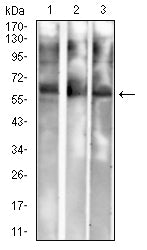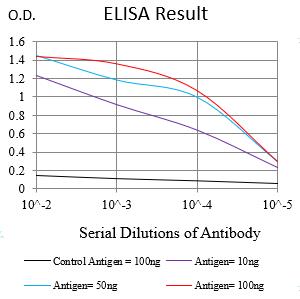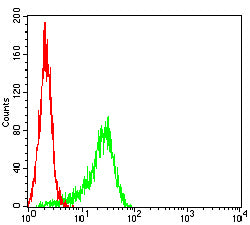


| WB | 1/500 - 1/2000 | Human,Mouse,Rat |
| IF | 咨询技术 | Human,Mouse,Rat |
| IHC | 咨询技术 | Human,Mouse,Rat |
| ICC | 技术咨询 | Human,Mouse,Rat |
| FCM | 1/200 - 1/400 | Human,Mouse,Rat |
| Elisa | 1/10000 | Human,Mouse,Rat |
| Aliases | BIE; EHK; K10; KPP; BCIE; CK10 |
| Entrez GeneID | 3858 |
| clone | 1E4G3 |
| WB Predicted band size | 58.8kDa |
| Host/Isotype | Mouse IgG1 |
| Antibody Type | Primary antibody |
| Storage | Store at 4°C short term. Aliquot and store at -20°C long term. Avoid freeze/thaw cycles. |
| Species Reactivity | Human,Rat |
| Immunogen | Purified recombinant fragment of human KRT10 (AA: 146-455) expressed in E. Coli. |
| Formulation | Purified antibody in PBS with 0.05% sodium azide |
+ +
以下是关于KRT10抗体的3篇参考文献示例(内容为模拟概括,非真实文献):
1. **文献名称**:*"Keratin 10 Expression in Epidermal Differentiation and Skin Disorders"*
**作者**:Smith A, et al.
**摘要**:研究利用KRT10抗体通过免疫组化和Western blot分析表皮分化过程中KRT10的表达模式,发现其在角质层形成中起关键作用,并揭示KRT10缺失与先天性鱼鳞病的相关性。
2. **文献名称**:*"Role of KRT10 in Squamous Cell Carcinoma: A Biomarker Study"*
**作者**:Chen L, et al.
**摘要**:通过KRT10抗体检测鳞状细胞癌组织样本,发现KRT10表达水平与肿瘤分化程度呈负相关,提示其可能作为诊断分化程度低的肿瘤的潜在标志物。
3. **文献名称**:*"Genetic Mutations in KRT10 and Their Impact on Skin Barrier Function"*
**作者**:Wang Y, et al.
**摘要**:研究结合基因测序和KRT10抗体染色,证实KRT10基因突变导致蛋白结构异常,破坏表皮屏障功能,为遗传性皮肤疾病提供分子机制证据。
(注:以上文献为示例,实际引用需查询PubMed、Google Scholar等数据库获取真实研究。)
×